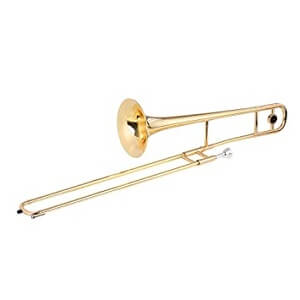Trombone
 The trombone's predecessor was a Belgian instrument known in England as a "sackbutt" that had a curved tube shape reminiscent of a paperclip, an extended slide section and a voice in the tenor register. While it looked quite a bit like the modern trombone, albeit with an extra twist in the middle of the tubing, it had a much smaller flare. Most sackbutt flares end at five inches or less in diameter. The sackbutt was typically equipped with a small set of extra tubes known as "crooks" which could be used to change the sackbutt's pitch and register as needed.
The trombone's predecessor was a Belgian instrument known in England as a "sackbutt" that had a curved tube shape reminiscent of a paperclip, an extended slide section and a voice in the tenor register. While it looked quite a bit like the modern trombone, albeit with an extra twist in the middle of the tubing, it had a much smaller flare. Most sackbutt flares end at five inches or less in diameter. The sackbutt was typically equipped with a small set of extra tubes known as "crooks" which could be used to change the sackbutt's pitch and register as needed.
Historians put a date of 1450 on the earliest of the sackbutts, though the earliest surviving examples today are from the 1500s. They were well known in sacred music and entered the orchestra in the 1700s. By that time, the sackbutt had been expanded into a family that included contrabass, bass, alto and tenor members. The instrument was thought of as one that was particularly flexible from an emotional standpoint: able to deliver both bombast and pathos.